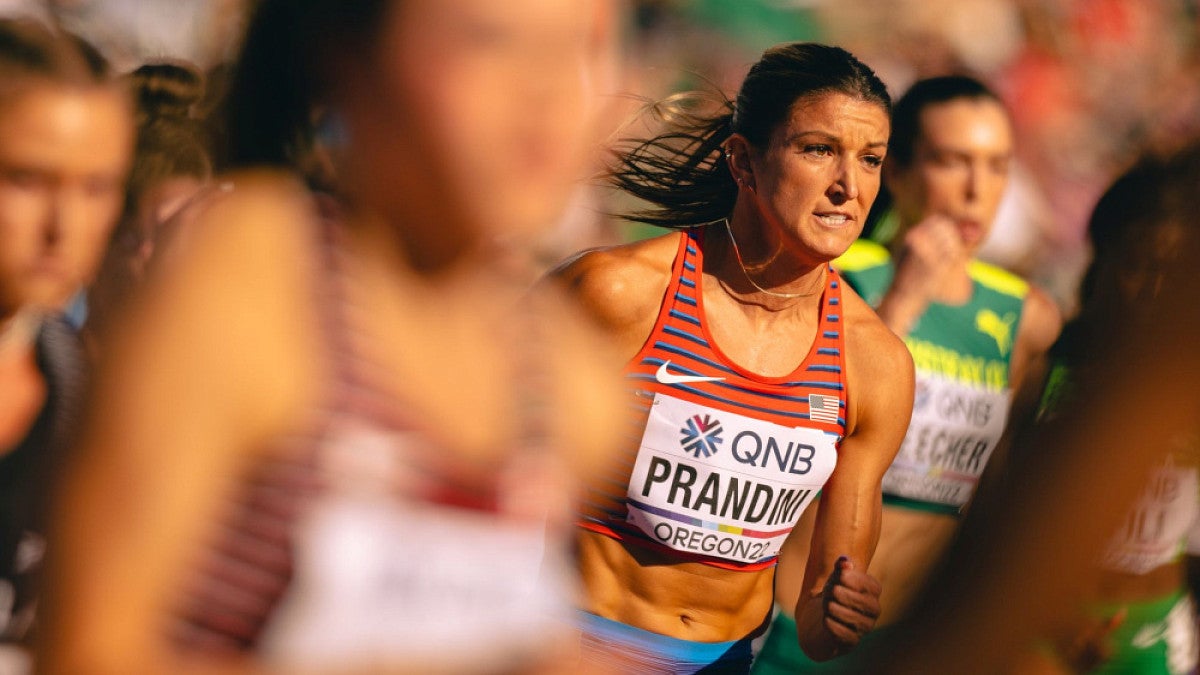An estimated one billion people watched the World Athletics Championship Oregon22 on television and online, almost 19 million of them in the U.S. alone. Combined with the thousands at Hayward Field, it was the competition’s most-viewed meet ever.
This was the first time the event was held in the United States or on a college campus. Some 1,700 athletes representing 179 countries plus a team made up of refugees competed, and nearly 150,000 ticketed fans watched at Hayward Field.
“For 10 days the world witnessed our beautiful campus and heard about the outstanding academic, research, student experience and athletic excellence at the UO,” President Michael H. Schill said in a message to campus. “Tens of thousands of visitors experienced Hayward Magic and a very warm UO welcome as they watched competition in person. I am impressed beyond words at the way in which students, faculty, staff and our neighbors came together to welcome the world and showcase the very best of the University of Oregon, Eugene and Oregon during the championships.”
It is finally here: @WCHoregon22. Our relentless pursuit for greatness — from the classroom to research to the field of competition — and how it fuels our students, faculty and staff will be on display for all the world to see.
— University of Oregon (@uoregon) July 15, 2022
It's another great day to be a Duck. #WCHOregon22 pic.twitter.com/nf3hVY0lGh
WCH Oregon22 provided an opportunity for the university community to showcase student and faculty research, discuss national and global challenges, and offer unique volunteer and professional experiences on a global stage.
“Hosting the world championships for the first time on a college campus was a tremendous undertaking,” said Carlyn Schreck, assistant vice president for presidential initiatives. “I am so proud of the hundreds of colleagues who made it a tremendous success. I am not at all surprised to see the overwhelmingly positive reports of the experiences athletes had in the residence and dining halls or the flood of thank-you emails from around the world.”
Through stories told by some the world’s most important media organizations — Reuters, NPR and The New York Times — as well as influential regional outlets such as The Oregonian, Oregon Public Broadcasting and NBC affiliates in Portland (KGW) and Seattle (KING), audiences learned about the influence of UO research, students’ contributions to the worldwide event and staff members who kept the athletes fed and the campus running.
And then there was the uplifting tale of an osprey chick learning to fly in view of the Hayward Field fans.
Spectators witnessed the triumphs and struggles of UO athletes who competed. Alumnae Jenna Prandini and Kemba Nelson earned medals, while crowd favorite Devon Allen lost his bid for glory by a nearly imperceptible false start: a thousandth of a second.
Thank you to the athletes, volunteers and fans for an incredible ride! #WCHOregon22 pic.twitter.com/saBN1rwbsF
— University of Oregon (@uoregon) July 25, 2022
Off the track, scholars, athletes and officials contributed to talks on the growth of the sport and its athletes. Several UO leaders met with second gentleman Douglas Emhoff and Oregon Gov. Kate Brown during a roundtable on mental health. The event paid tribute to International Women’s Day and the 50th anniversary of Title IX. The Out of the Blocks forum brainstormed strategies to bring more women into influential roles in athletics.
UO students snagged the ultimate summer jobs and gained practical real-world experience. They created video graphics and reported for international publications through the School of Journalism and Communication track bureau class, and planned the personality of the mascot through a paid internship via the Warsaw Sports Marketing Center. Student envoys helped international delegations adjust to life in Lane County.
Research by faculty members and their students went on before, during and after the event. Visitors could explore the Fuller Initiative Land Lab during a walk along the river and participate in an augmented reality game.
If you haven't already, check out the Fuller Land Lab located between Hayward Field and the Riverfront Festival. See research by @uoregondesign's Michael Geffel & others to better manage land & a special project w/@TravelOregon for @WCHoregon22. https://t.co/aDoxDWgwa0 #WCHOregon pic.twitter.com/vY1RZTtfGD
— University of Oregon (@uoregon) July 20, 2022
Directly related to the equipment on the track, students and faculty members from the Wu Tsai Human Performance Alliance at Oregon designed shoe sensor footwear to track shear force, optimizing performance and preventing injury.
Behind the scenes, researchers from the Institute for Sustainable Environment, Center for Science Communication Research, and Institute for Policy Research and Engagement monitored air quality while scientists monitored wastewater for COVID-19 and other viruses.
The staff of UO Dining used their foreign language skills while the chefs flexed their culinary skills serving a variety of healthy foods to an international contingent in the athlete village. Paul Swangard, a UO alumnus and journalism school instructor, conveyed the essence of Hayward Magic to a worldwide audience as the field event announcer for NBC Sports. Many UO staff members chose to volunteer during the 10-day event and called it a once-in-a-lifetime experience.


